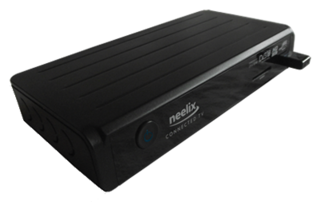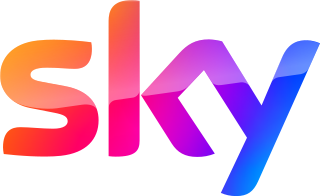Related Research Articles

Cable television is a system of delivering television programming to consumers via radio frequency (RF) signals transmitted through coaxial cables, or in more recent systems, light pulses through fibre-optic cables. This contrasts with broadcast television, in which the television signal is transmitted over-the-air by radio waves and received by a television antenna attached to the television; or satellite television, in which the television signal is transmitted over-the-air by radio waves from a communications satellite orbiting the Earth, and received by a satellite dish antenna on the roof. FM radio programming, high-speed Internet, telephone services, and similar non-television services may also be provided through these cables. Analog television was standard in the 20th century, but since the 2000s, cable systems have been upgraded to digital cable operation.
Telecommunications in Ireland operate in a regulated competitive market that provides customers with a wide array of advanced digital services. This article explores Ireland's telecommunications infrastructure including: fixed and mobile networks, The voice, data and Internet services, cable television, developments in next-generation networks and broadcast networks for radio and television.

A set-top box (STB), also known as a cable box or receiver and historically television decoder, is an information appliance device that generally contains a TV-tuner input and displays output to a television set and an external source of signal, turning the source signal into content in a form that can then be displayed on the television screen or other display device. They are used in cable television, satellite television, and over-the-air television systems as well as other uses.

Digital Video Broadcasting (DVB) is a set of international open standards for digital television. DVB standards are maintained by the DVB Project, an international industry consortium, and are published by a Joint Technical Committee (JTC) of the European Telecommunications Standards Institute (ETSI), European Committee for Electrotechnical Standardization (CENELEC) and European Broadcasting Union (EBU).
Television in the Republic of Ireland is available through a variety of platforms. The digital terrestrial television service is known as Saorview and is the primary source of broadcast television since analogue transmissions ended on 24 October 2012. Digital satellite and digital cable are also widely used.
Regular television broadcasts in the United Kingdom started in 1936 as a public service which was free of advertising, which followed the first demonstration of a transmitted moving image in 1926. Currently, the United Kingdom has a collection of free-to-air, free-to-view and subscription services over a variety of distribution media, through which there are over 480 channels for consumers as well as on-demand content. There are six main channel owners who are responsible for most material viewed.

Sky UK Limited is a British broadcaster and telecommunications company that provides television and broadband Internet services, fixed line and mobile telephone services to consumers and businesses in the United Kingdom. It is a subsidiary of Sky Group and, from 2018 onwards, part of Comcast. It is the UK's largest pay-TV broadcaster, with 12.7 million customers as of the end of 2019 for its digital satellite TV platform. Sky's flagship products are Sky Q and the internet-based Sky Glass, and its flagship channels are Sky Showcase, Sky Max, and Sky Atlantic.
Chorus, officially Chorus Communication Limited, was a communications provider in Ireland offering internet, television and telephone services. It was owned by Liberty Global Europe and ultimately controlled by John C. Malone's Liberty Media.
Now is a subscription over-the-top internet television service operated by British satellite television provider Sky Group. Launched in the United Kingdom in 2012, the service is also available in Ireland, Italy, Germany, and the United States.

Virgin Media is a British telecommunications company, founded in 2007, which provides telephone, television and internet services in the United Kingdom. Its headquarters are at Green Park in Reading, England. A range of videos advertising the company remain available on YouTube. It is owned by Virgin Media O2, a 50:50 joint venture between Liberty Global and Telefónica.
Sky Broadband is a broadband service offered by Sky UK in the United Kingdom. With the introduction of Sky Fibre, Sky Broadband now refers to ADSL broadband products.
TalkTalk TV is a UK-based consumer television and video on demand service, operated by the TalkTalk Group. It originally launched in 2000. In September 2012, the current TalkTalk TV was launched in partnership with YouView. Its television and video on demand service is delivered over a BT phone line, using ADSL or VDSL. It provides IPTV, video on demand, telephony and broadband internet access.

Virgin TV is a digital pay cable television service in the United Kingdom, owned by Liberty Global (50%) and Telefónica (50%) after the merger its UK businesses to form Virgin Media O2. Its origins date from NTL and Telewest, formerly two of the UK's largest cable operators, which merged on 6 March 2006. All NTL:Telewest services were rebranded as Virgin Media in February 2007. Since the acquisition of Smallworld Cable in 2014, Virgin is the sole national cable TV provider in Great Britain. Currently about 51% of UK households have access to Virgin's network, which is independent from BT's Openreach network.
There are four major forms of digital television (DTV) broadcast in the United Kingdom: a direct-to-home satellite service from the Astra 28.2°E satellites provided by Sky UK, a cable television service provided by Virgin Media ; a free-to-air satellite service called Freesat; and a free-to-air digital terrestrial service called Freeview. In addition, an IPTV system known as BT TV is provided by BT. Individual access methods vary throughout the country. 77% of the United Kingdom has access to HDTV via terrestrial digital television. Satellite is the only source of HDTV broadcast available for the remaining 23%.

The United Kingdom has been involved with the Internet throughout its origins and development. The telecommunications infrastructure in the United Kingdom provides Internet access to businesses and home users in various forms, including fibre, cable, DSL, wireless and mobile.
Smallworld Fibre was a British telecommunications company based in Irvine, North Ayrshire. Their coverage area used to be Irvine, Dreghorn, Troon, and Kilmarnock in the west of Scotland, and Carlisle, Lancaster and Morecambe in the northwest of England, where they served over 40,000 homes. Smallworld provided broadband, telephone, and digital television services to residential customers from 2001 to 2014, when the company was acquired by Virgin Media.
Cable first started in 1963, when several companies, including state broadcaster RTÉ, started relaying the UK's terrestrial TV channels in some cities and larger towns. Today all Irish cities and many larger towns have cable networks.
The distribution of cable television around the world:
This is a timeline of cable television in the United Kingdom.
References
- ↑ http://www.spacedaily.com/news/satellite-biz-01s.html BSkyB Completes Analogue Switch-Off Ahead of Target
- ↑ http://www.ispreview.co.uk/story/2011/04/04/bt-and-virgin-media-dispute-holds-back-faster-broadband-and-tv-in-milton-keynes-uk.html ISPreview – BT and Virgin Media Dispute Holds Back Faster Broadband and TV in Milton Keynes
- ↑ http://community.virginmedia.com/t5/TV/Milton-Keynes-Analogue-Cable-16-9-squashed-into-4-3/td-p/458811 Virgin Media Community Forum
- ↑ "BT fibre-to-the-premises trial takes 7 hours per install • The Register". www.theregister.co.uk.